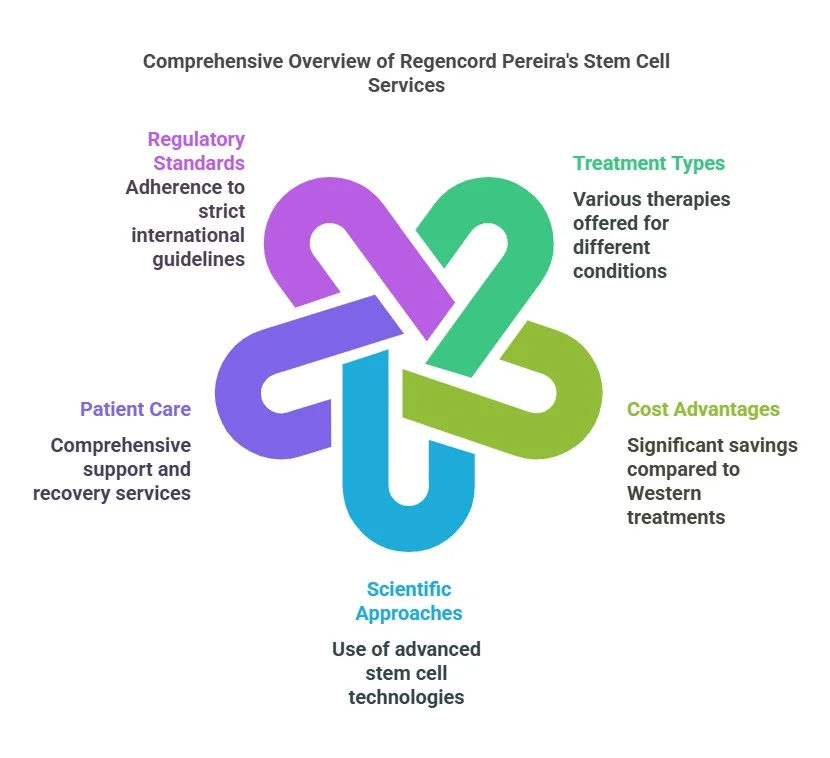

Patients can save significantly on placenta stem cell treatments in Colombia compared to the United States. The savings range from 50% to 80% on medical expenses. Stem cell therapy prices in the U.S. can reach $20,000 to $50,000, while Colombian facilities provide the same treatments for $5,500 to $14,000.
Colombia has become a top destination for stem cell therapy because of these price differences. The country’s INVIMA regulations maintain high safety and quality standards, similar to FDA regulations in the United States. Detailed treatment packages are a great way to get more value for international patients. They include many more therapies and accommodation options. This piece delves into why Regencord in Pereira provides affordable stem cells from the placenta without compromising quality. We break down the exact costs and compare them with options worldwide.


“Placenta-derived stem cells (p-SCs) are in between embryonic and mesenchymal stem cells, sharing characteristics with both, such as non-carcinogenic status and property to differentiate in all embryonic germ layers.” — Silvia Reis Oliveira, Researcher in stem cell biology
The regenerative medicine market is growing rapidly. Market projections indicate an expansion from $17 billion in 2016 to nearly $51 billion by 2025. The stem cell therapy segment is growing at 14.27% annually and should reach $9.95 billion by 2030. These numbers show both rising demand and changing cost patterns across treatments, including those utilizing stem cells in the placenta.
Stem cell treatment costs in 2025 vary based on complexity and source. Simple stem cell therapies cost under $5,000. Complex procedures with systemic treatment approaches can reach $25,000. Location plays a big role in pricing. Western European and American clinics charge between $20,000 and $50,000 for stem cell treatments, including those derived from placental tissue.
The biggest problem in regenerative medicine adoption remains cost barriers. Budget limits affect research institutions and patients despite technological progress. Many regions lack proper reimbursement policies, which makes treatments less available, especially in emerging economies with weak healthcare systems.
Placental stem cell treatments give patients a better deal than other stem cell sources. Costs range from $7,000 to $25,000. Several factors make this possible:
Doctors usually discard the placenta after birth. Using this "medical waste" eliminates expensive harvesting procedures needed for other stem cell sources. A healthcare leader puts it well: "We are saving hospitals from having to pay to incinerate this waste material, and we're turning it into a range of useful therapeutic products."
Placental tissue produces many viable cells with minimal exposure to infections or contaminants. This cuts down processing costs for screening and purification. The placenta contains various types of stem cells, including mesenchymal stem cells, which have shown great potential in clinical trials. The amniotic membrane, chorion, and other fetal membranes are rich sources of these valuable cells.
Stem cells from the placenta avoid regulatory hurdles and ethical concerns that affect embryonic stem cells. Compared to controversial sources, this speeds up approvals and reduces compliance costs by $10,000 to $15,000 per treatment. The use of placental tissue for stem cell extraction is generally considered more acceptable than using fetal stem cells.
Regencord uses several smart approaches to offer competitive prices while maintaining quality:
These strategies help Regencord offer treatments that cost 20-70% less than similar procedures in Western countries. More patients can now access advanced regenerative medicine without sacrificing quality or results. The affordability extends to various applications, including wound healing and tissue engineering.

Pereira, Colombia, has become a hub for medical innovation in the last few years. The city offers unique economic benefits to patients who want placenta stem cell treatments. Its position creates perfect conditions for affordable advanced therapies beyond the natural benefits of placenta-derived stem cells.
Healthcare costs in Pereira are much lower than in Colombia’s big cities. Medical facilities here spend less on staff, utilities, and real estate. These savings lead to lower expenses for specialized medical centers. The city’s GDP has grown by 11% year over year. This growth rate shows a strong economic environment that supports healthcare progress without big-city prices.
Medical centers in Pereira have 19.2 times fewer administrative costs than those in Bogotá and Medellín. They use efficient operational models that save money without affecting quality. Colombian healthcare ranks #22 globally, better than Canada (#30) and the United States (#37). The country houses 41% of Latin America’s best hospitals.
Patients benefit directly from Pereira's economic advantages. Medical tourists save 50-70% on procedures in Colombia compared to similar treatments in North America. Due to local economic factors, these savings are even higher at Regencord's Pereira facility.
Healthcare facilities in Pereira focus on efficiency through:
Colombia spends just 6.8% of its GDP on healthcare (USD PPP 930 per person). Yet the coverage is impressive, including 96.9% of health procedures and 93.7% of approved medications. This efficient system makes specialized treatments like placenta stem cell therapy available at much lower prices than international options.
Colombian government policies have helped make Pereira a center for medical innovation. These incentives create conditions for advanced treatments to grow and remain affordable.
The number of free trade zones in Pereira has grown from 6 to 14 in the last decade. This growth shows the government's plan to develop the region as an international investment hub, especially for healthcare and biotech. These zones offer tax benefits that help medical facilities reduce their operating costs for advanced treatments, including those using placental stem cells.
Government funding helps boost corporate R&D in healthcare technology. These programs help facilities like Regencord use innovative processing methods without increasing patient costs. The government balances market needs with strong regulations to maintain high-quality care while staying efficient.
These government incentives help invest in advanced placenta processing technologies that would otherwise cost too much. Support during development phases lets facilities offer modern treatments at prices well below international rates.


Regencord’s innovative facility uses specialized techniques that lower the cost of placenta stem cell treatments without affecting quality. A look at their internal operations shows how technological breakthroughs and strategic management create real price benefits for patients.
Regencord’s proprietary placenta processing methods follow multiple ISO standards, including ISO 9001 for management systems and ISO 14644 for cleanroom air quality. This standardized approach yields higher cell yields from each placental sample. A single placenta can yield between 100 and 100,000+ therapeutic doses, depending on the application.
Placental tissue is normally discarded after birth, unlike traditional stem cell sources that need invasive harvesting procedures. “We are saving hospitals from having to pay to incinerate this waste material, and we’re turning it into a range of useful therapeutic products,” noted one industry expert. This medical waste repurposing eliminates major collection costs that would otherwise affect patients.
Regencord uses modular production methods that make manufacturing "efficient, scalable, and reproducible." This approach cuts production time and reduces waste during cell processing. Patients get a full picture to determine suitability and customize treatment plans, ensuring resources aren't wasted on inappropriate applications.
The clinic's treatment protocols include:
These standardized procedures reduce administrative work, which lowers costs. Stem cell treatment can range from under $5,000 for simple procedures to over $25,000 for complex ones. Regencord's efficient measures create valuable savings.
Regencord has built an extensive network of ethically sourced biomaterials through local partnerships. Their regional supply chain eliminates international shipping costs and import duties that would increase treatment expenses.
The clinic cooperates with local healthcare providers for complementary services to create a budget-friendly ecosystem. These strategic collaborations extend to rehabilitation facilities. Patients receive complete care packages that typically include physical rehabilitation, nutritional counseling, and pain management.
These strategic relationships help Regencord deliver placenta stem cell treatments starting at €6,306 (USD 6,900) for conditions like knee osteoarthritis. The cost is 65-75% less than comparable treatments in North American facilities where prices often exceed $20,000.
Patients researching placenta stem cell treatment often focus on the cost. Regencord stands out with some of the most competitive prices in the global regenerative medicine market.
The Regencord facility in Pereira charges $6,306 or USD 6,900 for placenta stem cell treatment of knee osteoarthritis. This price tag sits 75% below similar treatments in the United States, where patients pay between USD 15,825 and USD 26,900. The significant price difference comes from Colombia’s economic advantages rather than any quality compromise.
The clinic makes pricing crystal clear to avoid the confusion that typically comes with medical tourism. However, prices might change based on the complexity of the procedure and the patient’s specific condition.
A comprehensive package that has hotel accommodations costs USD 7,900, which makes life easier for international patients. Each treatment package has:
Patients should know that travel expenses, meals, extra medical treatments beyond the original therapy, and managing any complications aren't part of these packages.
Insurance rarely covers stem cell treatments, so Regencord and other specialized clinics make treatment more available through financing options. Cherry, a third-party financing company, offers flexible payment plans with qualifying 0% APR options. CareCredit, a healthcare-specific credit card, gives patients another way to manage payments.
Patients can spread their treatment costs over 6-36 months, depending on their financial situation and credit score.
Most insurance providers call stem cell treatments experimental and don't cover them. International patients seeking treatment in Colombia face extra challenges because of this lack of coverage.
Patients usually pay high out-of-pocket costs. Insurance companies only cover procedures they think are medically necessary and approved by regulatory bodies in their home countries. Getting insurance approval becomes even harder because stem cell therapy lacks standardized categorization.
Most patients ended up paying directly for placenta stem cell treatment. Sometimes, insurance companies approve cases they consider medically necessary with strong scientific backing.


Understanding stem cell therapy costs worldwide can help you make smart treatment decisions. Price differences across markets can shape where patients end up getting their treatment.
Regencord isn’t the only reputable clinic in Colombia that offers stem cell treatments. You’ll find good alternatives like Alevy, Stem Cells Kyron, and other specialized regenerative service providers. Colombian providers charge USD 5,000 to USD 8,000 on average per treatment. Here’s what specific therapies might cost you:
The price gap between Colombia and Western countries is huge. American clinics charge USD 20,000 to USD 50,000 for the same procedures, making Colombian options about 70% cheaper. European prices range between USD 5,000 and USD 20,000, and Austria's average is around USD 12,000.
Understanding stem cell therapy costs worldwide can help you make smart treatment decisions. Price differences across markets can shape where patients end up getting their treatment.
Regencord isn't the only reputable clinic in Colombia that offers stem cell treatments. You'll find good alternatives like Alevy, Stem Cells Kyron, and other specialized regenerative service providers. Colombian providers charge USD 5,000 to USD 8,000 on average per treatment. Here's what specific therapies might cost you:
The price gap between Colombia and Western countries is huge. American clinics charge USD 20,000 to USD 50,000 for the same procedures, making Colombian options about 70% cheaper. European prices range between USD 5,000 and USD 20,000, and Austria's average is around USD 12,000.
Regencord’s placenta stem cell treatments in Pereira provide big cost savings without cutting corners on quality. Patients pay just $6,900 to $7,900 for treatments that cost $20,000 to $50,000 in the U.S. These lower prices come from smart location choices, modern processing technology, and a streamlined operation system.
Quality care remains Regencord’s top priority. The facility follows strict international standards, with ISO certifications and detailed treatment protocols. Patients can plan their medical trips with confidence because the pricing is clear and upfront, with no hidden costs.
Most insurance plans don’t cover stem cell treatments. However, Regencord’s competitive prices and financing options make these advanced treatments available to more people. International patients save money even after adding travel costs. They get high-quality care in Colombia’s well-regulated medical system that costs much less than in Western countries.
We focus on knee treatment using stem cell therapy, focusing on three main processes:
Stem cells are unique cells with the ability to develop into various cell types and repair damaged tissues. They are used in regenerative medicine, including treatments for cancer, neurodegenerative diseases, and injuries. Sources include bone marrow, cord blood, and embryos.
(888) 540-4101
Begin your journey with us today! Call us at (888) 540-4101 or complete the form to learn more.


